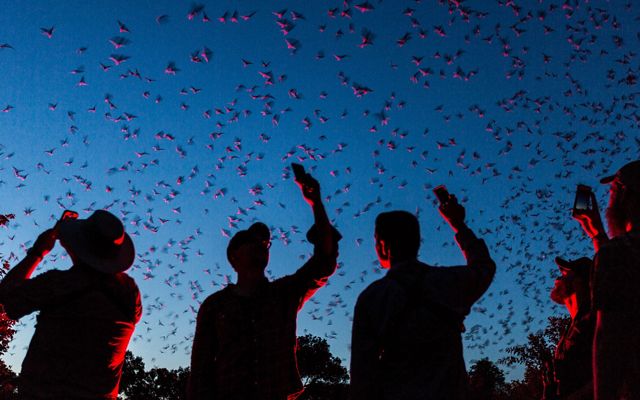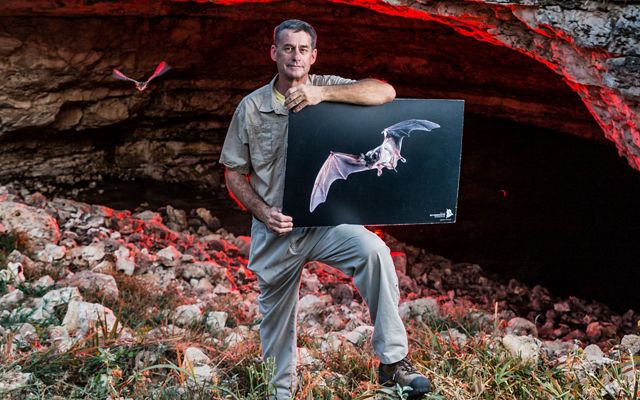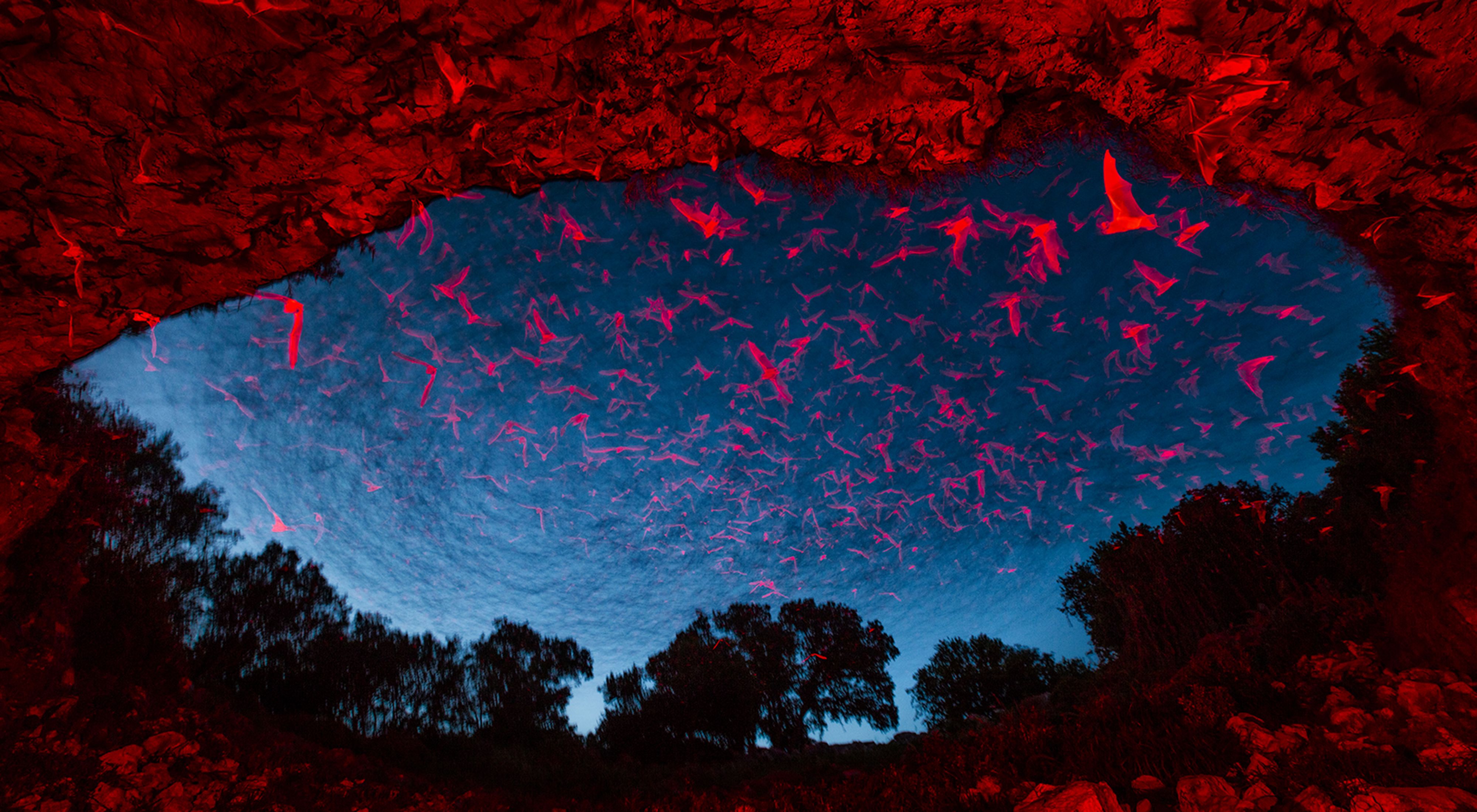As the evening light begins to fade in central Texas, a spectacular performance takes shape at the mouth of Bracken Cave, outside San Antonio. The show starts with the barely perceptible flutter of bat wings in the shadows—like the stirring behind a curtain before a stage production.
Then a couple of brave scouts take a flight into the twilight before quickly retreating. A few minutes later, a trickle of bats rises into the night air, followed by a stream and then a flood. For the next three hours, millions of the animals issue forth and circle at the mouth of the cave, creating a swirling bat vortex—a living tornado. The undulating mass of bodies rises to clear the ridge above the cave and continues skyward into a light wind, where it fractures apart in different directions. The horizon goes gray with ribbons of flapping wings that carry mothers and their young off to feed on insects throughout the night.
From March through October, this massive whirling and swirling emergence repeats every night at dusk as 15 million to 20 million Mexican free-tailed bats fly out from Bracken Cave, home of the densest concentration of mammals on the planet.
“It sounds like running water, doesn’t it?” says Fran Hutchins, the director of Bat Conservation International’s cave preserve. “In summer months, the closest we get to rain is listening to bats.” Hutchins smiles as he watches the torrent of bodies disappear into the darkness to forage. Fullgrown adults will travel up to 60 miles away—and back—during the night, while the young will learn to hunt much closer to the cave. Before its return, the swarm will consume millions of pounds of insects.
Two years ago, the rolling terrain of live oaks and Ashe juniper trees that the bats fly over became the center of a controversy almost as dramatic as the bat show itself. A development company was ready to build a neighborhood of 3,500 homes very close to the cave. Staff from Bat Conservation International and The Nature Conservancy—which owns land adjoining the cave preserve and the proposed subdivision—feared that putting so many houses in the bats’ flight path would turn residents against the animals. To save Bracken, the organizations had to face off with developers and rally the support of politicians and the people of Texas by convincing them all of the irreplaceable value of a big hole in the ground.

Bat-watching is a full-on tourist attraction in central Texas. Other nearby caves—at Old Tunnel State Park and the Conservancy’s Eckert James River Bat Cave Preserve—are open to the public for bat viewing. The biggest crowds come out to see the emergence of up to 1.5 million Mexican free-tailed bats that live under the Congress Avenue Bridge in downtown Austin, the largest urban bat colony in the world. There’s even an annual Bat Fest in Austin that closes the bridge to traffic for a day to make way for live music, arts-and-crafts vendors and food booths. For all of its wonderfully weird Austin-ness, the celebration and nightly viewings illuminate the enigmatic bats and educate watchers on the animals’ characteristics and critical roles in the regional ecosystem.
The scene at Bracken Cave is quieter and more controlled. Bat Conservation International limits access to the preserve to avoid disturbing this extraordinary and vulnerable colony of bats. The preserve is open only a few nights a week to small groups who sit in rows of benches in reverent awe as the wings fl utter above them.
The bats’ name ties them to Mexico, and they range throughout much of the southern United States, but it’s in central Texas that these bats (a subspecies of the Brazilian free-tailed bat) have become stars of the natural world. Before arriving here in March from Mexico, where they spend the winter, the bats mate. The males form their own bachelor colonies, and the pregnant females move between about a dozen caves within a 100-mile radius of San Antonio. The largest colony inhabits Bracken Cave.
“The cave is a perfect nursery because it’s a giant incubator,” Hutchins says, standing in front of the cave’s oval mouth. The temperature inside remains a stable 102 to 104 degrees, thanks to the insulation of rock and soil and the millions of bat bodies.
To feed their babies, which are born in early summer, the mothers eat voraciously, consuming one-half to three-fourths their body weight in insects per night. Their formidable appetite provides a critical benefit to central Texas: wide-reaching insect control. On their nightly forages, the Bracken bats alone can eat 140 tons of flying beetles, winged ants and moths. They’re particularly fond of common agricultural pests; one study showed that the bats save the region’s cotton growers $741,000 per year in pesticide costs and crop damage.
Though the bats eventually spread out in all directions, the immediate route out of Bracken Cave is almost always to the south. “Bats take off into the wind, like an airplane,” says Hutchins, pointing out that the prevailing winds are from the southeast and southwest. But that direction started looking like a collision course into a new housing development.

In early 2013, a nearby landowner announced plans to court developers who would build a dense suburban development with 10,000 residents on 1,521 acres adjacent to Bracken Cave. “Imagine a subdivision at the end of an airport runway,” says Laura Huffman, Texas state director for the Conservancy, which owns the Cibolo Bluffs Preserve that adjoins the proposed subdivision.
When Bracken’s pups are building their flying skills in midsummer, they use nearby land to catch their breath, explains Andrew Walker, executive director of Bat Conservation International. “These bats are attracted to buildings as roost sites and to the insects drawn by porch lights,” he says. “The chances that children or pets would find resting or ill bats would have been very high.” Given that bat bites are treated by preventive rabies shots, Walker believes, residents would likely have become irritated with the bat cave.
It’s not unprecedented for people—annoyed or scared by bats—to set fire to caves or close up the entrances with chicken wire. Building a massive neighborhood next to the world’s largest gathering of mammals seemed like a bad idea for all involved. So Bat Conservation International decided it was time to raise the cave’s profile, while The Nature Conservancy set out to find a way to purchase the property.
Ron Nirenberg was running for the San Antonio city council in spring 2013 when he first heard about the proposed subdivision and the threat to the bats. Among the first things he did after taking office was go to Bracken Cave with his staff to witness the emergence. “I posted a video of the bats on my Facebook page and was blown away by the response,” he says. Hundreds shared it—in Texas and beyond. “I realized this is a big deal,” he says. “Not just for San Antonio.”
Central Texas has been one of the fastest-growing regions of the country in the past decade, and the threats to Bracken Cave were part of a larger challenge facing the booming cities. The undeveloped land around the cave doesn’t just protect bats, Nirenberg says; it is also
crucial for capturing the rainwater that funnels down and recharges the Edwards Aquifer, which supplies 90 percent of San Antonio’s water. “I wanted to stake out a public-private (conservation) model that could handle these kinds of challenges in the future.”
In a matter of weeks, Bat Conservation International drummed up save-the-cave support through stories in the likes of The New York Times and Caving News, and kicked off a Facebook campaign that inspired viewers and explained the benefits of the Bracken bats. Besides offering the visual spectacle of the nightly emergences, Bracken Cave helped Texans understand the role of bats in their environment. Without bats from Bracken and the other caves, the region would be burdened with more insects and subsequently more pesticides. The campaign led to packed city council meetings. Behind the scenes, Nirenberg, along with the Conservancy, approached government officials looking for a solution.
Eventually, public pressure prompted the developer to back out of the deal, and the Conservancy was able to buy the land for $20.5 million with help from Bat Conservation International and a coalition of local and federal agencies and private donors. The deal protects groundwater for the city, endangered golden-cheeked warbler habitat and the bat cave. It is, as Huffman calls it, “a trifecta of conservation success.” The purchase was finalized on Halloween 2014.
Bat Conservation International and the Conservancy split the acreage on the new parcel and will manage it jointly. “Since there won’t be any fences, we will be operating as one big preserve,” says Rachael Ranft, director of the Conservancy’s Northern Hill Country river projects. Activities on this pristine slice of Hill Country land will include scheduled hiking, tours and presentations by naturalists. But the headliner will always be the bats—because there is nothing that compares to this gathering of animals in the entire world.
Now, with the cave permanently protected, the future of the bats is secure and the only neighbors are those who come to be astounded by the spectacle. “Oh, wow! The floodgates have opened,” says one spectator at a recent emergence, her head bent back to watch what look like pepper flakes in a windstorm. “Beautiful. Beautiful. Absolutely beautiful,” she murmurs. “Bon appétit, beautiful bats.”

